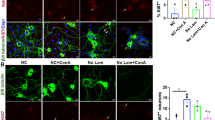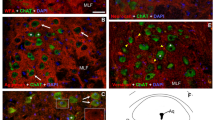Abstract
NEURONAL cell death is a conspicuous part of development for many neuronal populations in the vertebrate nervous system1,2. Although little is known about the mechanisms that control neurone death, it seems that interactions with the postsynaptic target tissue are important. Thus, for the chick ciliary ganglion (CG), Landmesser and Pilar showed that half of the neurones present die between days 8 and 13 in the embryo. Before cell death, all the neurones extend processes to the periphery. Ablating the periphery early in development causes more than 90% of the neurones to die at the normal time3. We have previously shown that nearly all the neurones from chick CG, including those destined to die in vivo, can survive and develop in cell culture when ganglia from 8-d-old embryos are dissociated and grown with skeletal myotubes4. Many of the neurones innervate myotubes in these conditions. Are neuromuscular synapses necessary to prevent the death of ciliary ganglion neurones? We report here that they are not. Culture medium conditioned by contact with heart or skeletal muscle cells permits complete long-term survival of the dissociated neurones grown in the absence of other cell types. The neurones develop levels of choline acetyltransferase (CAT) activity comparable to those obtained for neurones grown with myotubes.
This is a preview of subscription content, access via your institution
Access options
Subscribe to this journal
Receive 51 print issues and online access
$199.00 per year
only $3.90 per issue
Buy this article
- Purchase on Springer Link
- Instant access to full article PDF
Prices may be subject to local taxes which are calculated during checkout
Similar content being viewed by others
References
Cowan, W. M. in Development and Aging in the Nervous System (ed. Rockstein, M.) 19–41 (Academic, New York, 1973).
Jacobson, M. Developmental Neurobiology, 2nd edn (Plenum, New York, 1978).
Landmesser, L. & Pilar, G. J. Physiol., Lond. 241, 715–736, 737–749 (1974).
Nishi, R. & Berg, D. K. Proc. natn. Acad. Sci. U.S.A. 74, 5171–5175 (1977).
Fischbach, G. D. Devl Biol. 28, 407–429 (1972).
Helfand, S., Smith, G. A. & Wessells, N. K. Devl Biol. 50, 541–547 (1976).
Collins, F. Devl Biol. 65, 50–57 (1978).
Helfand, S. L., Riopelle, R. J. & Wessells, N. K. Expl Cell Res. 113, 39–45 (1978).
O'Lague, P. H., Obata, K., Claude, P., Furshpan, E. J. & Potter, D. D. Proc. natn. Acad. Sci. U.S.A. 74, 3602–3606 (1974).
Chiappinelli, V., Giacobini, E., Pilar, G. & Uchimura, H. J. Physiol., Lond. 257, 749–766 (1976).
Landmesser, L. & Pilar, G. Fedn Proc. 37, 2016–2022 (1978).
Njå, A. & Purves, D. J. Physiol., Lond. 277, 53–75 (1978).
Barald, K. F. & Berg, D. K. Devl Biol. (in the press).
Berg, D. K. & Fischbach, G. D. J. cell Biol. 77, 83–98 (1978).
Author information
Authors and Affiliations
Rights and permissions
About this article
Cite this article
NISHI, R., BERG, D. Survival and development of ciliary ganglion neurones grown alone in cell culture. Nature 277, 232–234 (1979). https://doi.org/10.1038/277232a0
Received:
Accepted:
Issue Date:
DOI: https://doi.org/10.1038/277232a0
This article is cited by
Comments
By submitting a comment you agree to abide by our Terms and Community Guidelines. If you find something abusive or that does not comply with our terms or guidelines please flag it as inappropriate.



